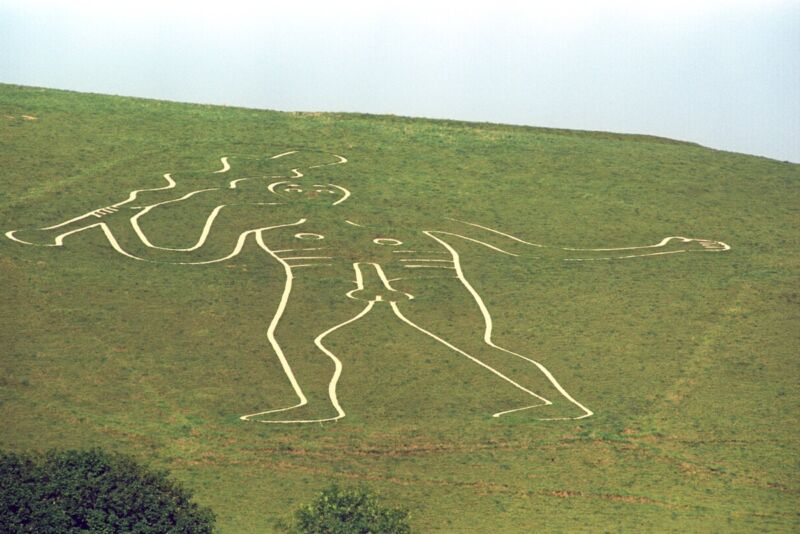Enlarge / Behold, the “Rude Man” chalk giant carved on a hill above the village of Cerne Abbas in Dorset, England. Barry Batchelor/PA Images/Getty Images reader comments 2 A major attraction of Dorset, England, is the Cerne Abbas Giant, a 180-foot-tall figure of a naked man wielding a large club carved with chalk into a hilltop. A pair of historians offers a strong case that this figure was originally meant to represent Hercules from Greek mythology, perhaps to inspire West Saxon armies, who could have used the site as a muster station.
They outlined their arguments in a recent paper published in the journal Speculum. The authors also found a possible early reference to the giant in texts dating back to the mid-11th and early 12th centuries, a period in which the carving may have been reinterpreted as representing Saint Eadwold of Cerne . “It’s become clear that the Cerne giant is just the most visible of a whole cluster of early medieval features in the landscape,” said co-author Helen Gittos, an early medieval historian at the University of Oxford, told The Guardian .
“I think we’ve found a compelling narrative that fits the giant into the local landscape and history better than ever before, changing him from an isolated mystery to an active participant in the local community and culture. ” As reported previously , the Cerne Abbas Giant ‘s generously sized erect phallus has earned it the nickname “Rude Man,” which undoubtedly contributes to its popularity as a tourist attraction. Archaeologists have long speculated about exactly when and why the geoglyph was created.
Further Reading Archaeologists “flabbergasted” to find Cerne Giant’s origins are medieval The Cerne Abbas Giant was formed by cutting trenches two feet deep into the steep hillside and then filling them with crushed chalk. Some scholars believed the giant might date back to the Iron Age as a fertility symbol. Local folklore holds that copulating on the giant’s crotch will help a couple conceive a child, and there is an Iron Age earthwork known as the Trendle at the top of the hill in which the giant has been carved.
However, there is no mention of the figure in a 1540s survey of the Abbey lands, nor in a 1617 survey conducted by the English cartographer John Norden . Advertisement The earliest known written reference to the Cerne Giant appears in a 1694 warden’s account from St. Mary’s Church in Cerne Abbas , recording the cost of three shillings to repair “ye Giant.
” There are also references to the figure in a 1734 letter by the then-Bishop of Bristol and a 1738 letter by antiquarian Francis Wise. The first survey to mention the giant was published in 1763 and included measurements and a drawing. After that, mention of the giant becomes far more common in the historical record.
In 2021, archaeologists pronounced themselves “flabbergasted” when an analysis of sediment samples narrowed down the likely date for the Rude Man’s creation to the late Saxon period—a surprising result since no other similar chalk figures in the region are known to date from that period. Many archaeologists and historians thought he was prehistoric or post-medieval, but not medieval. In the 1990s, archaeologists relied on soil samples to date another well-known geoglyph—the 360-foot-long Uffington White Horse in Oxfordshire—to between 1380 and 550 BCE.
And the Long Man of Wilmington in East Sussex dates back to the 16th century. The deepest samples—taken from the giant’s elbows and feet—rule out a prehistoric Roman origin, indicating that the giant was probably first made by late Saxons sometime between 700 and 1100 CE. However, other samples indicate a later date of around 1560—still predating the first recorded mention of the giant in the 1694 church warden’s account.
People may have been re-chalking the Rude Man over a very long period, which would explain the different dates, as well as all the evidence suggesting the giant’s features have changed over time. A 2020 lidar scan, for instance, revealed that the impressive phallus had been added later. .
From: arstechnica
URL: https://arstechnica.com/?p=1994228
